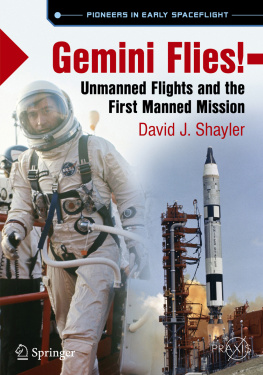1. Mercury Mark II
If there had been no Mercury program,
there would be no Gemini program;
if there had been no Gemini program,
there could be no Apollo program.
Virgil I. Gus Grissom, Gemini .
For a long time, Gemini was a program overshadowed by the achievements of Apollo (1960-1975) and the initial American manned space program, Project Mercury (1959-1963). Now, however, it is seeing a resurgence of interest in its operations, half a century after the missions were flown. One reason for its relative anonymity is that Gemini was an intense but short-lived program, created in the early 1960s and matured over just three years. It was operational for just over 30 months and, despite grand plans, was all over by the end of 1966. Nevertheless, NASAs second manned space program was an indispensable lynch-pin between Americas pioneering days with Project Mercury and the efforts to place the first humans on the Moon during Apollo. It also provided the groundwork for more extensive manned spaceflight operations, by developing key procedures that had application far beyond the Moon program of the 1960s. Gemini richly deserves recognition for its contributions both to the American program and to the global development of human spaceflight.
Gemini was created to serve a purpose and, despite a somewhat shaky start, achieved almost all that was expected of it. Those who worked on the program retained an affection for it that lasted far longer than the program itself. As Gus Grissom, who had helped to nurture the spacecraft to operational status, wrote shortly before he tragically lost his life, without Gemini, born of Mercury, there would have been no Apollo; at least, not as history records and certainly not as smoothly as the six missions demonstrated between October 1968 and November 1969, as they reached for the Moon during a spectacular year of achievement.
Playing catch-up
The Gemini program was created to meet an immediate need in the American space program: to gain experience in regular spaceflight operations. Project Mercury had proved that man could be launched into space aboard a one-shot space capsule, could perform some basic, useful work there and could survive the fiery re-entry to return to Earth, or more accurately water, with a splashdown in the planets large oceans. By the time the Gemini program was formally initiated, the United States had already been set the national goal of landing a man on the Moon and returning him safely to the Earth by the end of the decade. The historic speech by U.S. President John F. Kennedy on May 25, 1961, was made partly in response to the recent and to a degree embarrassing one-orbit flight of Soviet cosmonaut Yuri A. Gagarin aboard the spacecraft Vostok, as well as the disastrous CIA-led invasion at the Bay of Pigs against the communist-led island of Cuba.
In order to achieve Kennedys goal, Gemini would first have to prove that longer spaceflights were possible, that rendezvous and docking could be achieved and that spacewalking, given adequate preparation and equipment, could be mastered. Since the American program was open to the world, Gemini would offer this evidence to other nations wishing to address these issues.
However, that was in the future. Back in the early 1960s, America was severely lacking in space leadership; so much so that the Soviets would grab most of the worlds headlines in the first eight years of the space age: (1957) the first satellite and the first living creature (the dog, Laika) in orbit; (1959) the first lunar probe (Luna), the first object to reach another celestial body (the Moon with Luna 2) and the first spacecraft to pass behind the Moon and take images (Luna 3); (1961) the first man in space (Yuri Gagarin) and the first 24-hour manned spaceflight (Gherman S. Titov); (1962) the first dual flight (Vostok 3 and Vostok 4); (1963) the first long-duration flight (five days, Vostok 5) and the first woman in space (Valentina V. Tereshkova, Vostok 6); (1964) the first space crew (three cosmonauts aboard Voskhod 1); (1965) the first spacewalk (Alexei A. Leonov on Voskhod 2).
It was not until the program of ten manned Gemini missions, launched on average at three-month intervals between March 1965 and November 1966, that America finally began to overhaul the Soviet lead in the so-called space race. It was Gemini that allowed the Americans to develop the procedures needed not only to reach the Moon, but to establish a routine access to space, supported by pinpoint recovery and an extensive ground infrastructure. Five decades after the Gemini program concluded, these systems, together with the previously mentioned rendezvous and docking, spacewalking and long-duration spaceflight techniques, are precisely the same ones employed to keep the International Space Station flying.
THE ORIGINS OF A PROGRAM
Five years before a Gemini spacecraft left the launch pad, the possibility of such a program was explored during a meeting of a NASA committee chaired by Harry J. Goett of the Ames Research Center. During the two-day meeting, held over May 25 and 26, 1959, the committee evaluated the idea of enlarging the design of the one-man Mercury spacecraft by fifty percent to accommodate two astronauts for two to three days. The idea of an upgraded Mercury spacecraft was appealing not only to NASA but also to prime contractor McDonnell, as Mercury was severely limited for anything beyond supporting the solo pilot for up to one day, with little opportunity to perform scientific experiments and no capability for either maneuvering or leaving the spacecraft in orbit.
In August 1959, while McDonnell looked into what would be required to modify the basic Mercury design, elements of the Space Task Group (STG) began to look more seriously at an even more advanced Mercury-type spacecraft. On August 12, the STGs New Projects Panel requested the groups Flight Systems Division to begin studies of a second-generation manned spacecraft that had significant improvements over the original Mercury. By April 1961, a number of new systems had been proposed for this advanced Mercury spacecraft, most notable of which were the inclusion of a re-entry control navigation system to improve the accuracy of landing and the installation of controls to allow the crew to perform a rendezvous in orbit with a second vehicle.
Enter Apollo and Vostok
The idea, indeed the desire, to develop a large spacecraft to support an advanced space program that would include manned flights to the Moon, had its initial support in the late 1950s, both in the military and at NASA. During the same STG meeting in August 1959, discussions into the idea of improving the Mercury spacecraft ran parallel to the New Project Panels focus upon the future manned program and a proposed second-generation, three-man capsule. This would include the potential for near-lunar return velocities, in other words flights around the lunar far side more commonly known as circumlunar trajectories and would use the new large Saturn launch vehicle. On July 25, 1960, as these studies continued, the name Apollo was chosen for the advanced three-man spacecraft, with plans to utilize them to support manned lunar landings and to service a permanent space station.
In February 1961, McDonnell held discussions with NASA about how they envisaged improving the design of Mercury to include a second astronaut. In fact, these studies pointed to two different versions of the advanced Mercury spacecraft. Firstly, minimal changes would be made to the basic Mercury spacecraft, allowing one astronaut to fly for 18 orbits (27 hours, or 1 day). More significant changes would be required to improve the design sufficiently to support two men on more advanced missions and this clearly pointed towards a brand new spacecraft. For a while, this improved concept became known as Mercury Mark II, instead of Advanced Mercury, based upon the suggestion of STG contracting officer Glenn F. Baily and John Y. Brown of McDonnell Aircraft Corporation. On April 14, 1961, just two days after Yuri Gagarin became the first man to fly in space, NASA issued a study contract to McDonnell for improving the Mercury spacecraft. Plans were being put in place for far more advanced missions even before the basic one-man design had flown with an astronaut on board.







